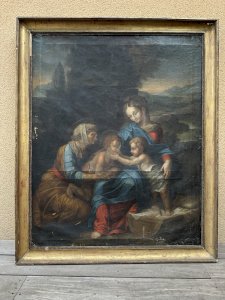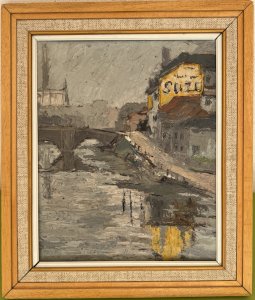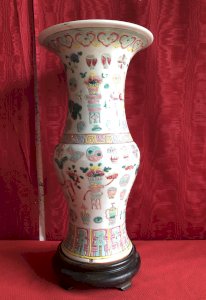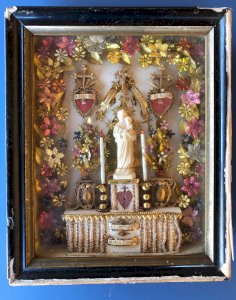- Sell Now
- Home
-
FURNISH
All STORAGE FURNITURE • Wardrobe • Chests of drawers, Chiffonnier • Sideboard • Shelves, Bookshelves • File cabinet • Sewing Furniture • Bar cabinet • TV Stand • Trunk, Chest TABLE & BEDSIDE TABLE • Dinner Table • Coffee table, side table, end table & Bedside • Console, Pedestal table & Selette • Serving Table, Trolley • Card Table • Draper's counter & table SEAT • Sofa • Armchair • Chair • Stool • Bench • Daybed • Beanbag & Footrest • Deckchair & Outdoor DESK, SECRETARY, DRESSING TABLE GARDEN LOUNGE BEDDING • Bed • Bedhead • Cradle, Moses basket CRAFT FURNITURE, WORKSHOP • Workbench • Stool, Ladder, Step • Easel & Trestle SCREEN PIANO
-
DECORATE
All TO PUT • Sculpture, Statuette • Vase & Planter • Dame Jeanne, Bonbonne & Flacon • Bridal globe, Dome • Pin tray, Ashtray • Candlestick & Candle • Photo frame • Stone, Fossil, Mineral • Earth Globe MIRROR WALL DECORATION • Painting • Engraving & Illustration • Poster • Tapestry • Wall Frame • Plate & Sign • Juju Hat & Wall Paniel • Mask • Hunting Trophy • Other object to hang CLOCK, PENDULUM & ALARM CLOCK ARRANGEMENT • Jar, Box & Case • Basket, Wastebasket & Crates • Magazine Rack & Vinyl Holder • Display & Spinner • Coat hook & Coat rack • Furniture Valet & Mannequin • Towel Holder • Suitcase & Travel Bag • Bottle Rack • Umbrella holder BATHROOM OFFICE • Mail holder • Bookends • Sulphide & Paperweight • Stationery FIREPLACE ACCESSORIES HOBBIES • Vintage Sport • Music • Vintage device • Smoking Item • Militaria, Ancient weapon • Miniature Vehicle • Game, Playing Cards • Collection object & Curiosity BIRD CAGE RELIGION, SPIRITUALITY
- TEXTURE
- ILLUMINATE
-
ACCOMODATE
All TABLE & SERVING • Plate • Silverware • Knife Holder • Glass • Bowl, Mug, Cup • Bowl, Ramekin & Cup • Dish, Cup & Salad Bowl • Tray, Basket & Server • Table Mat • Pitcher, Carafe, Bottle, Tea & Coffee Jug • Ice Bucket • Salt & Pepper shakers, Oil & Vinegar shakers • Sugar and jam maker • Gravy boat • Butter dish • Egg cup • Terrine OLD BALANCE CUTTING BOARD GRINDER CASSEROLE, SAUCEPAN & PAN KITCHEN UTENSIL & ACCESSORY
- TINKER
- KIDS
- Jewelry & Accessories
Login
Related Products
Description
François-Louis LANFANT de METZ (1814 - 1892) Oil on cardboard representing the charming scene of a child playing with a squirrel. Ref C4 Dimensions with frame: 28.5 x 24 cm Dimensions of the painting: 18.5 x 14.5 cm Signed lower right Sold as is François Louis LANFANT de METZ "Les Pecheuses" Painter of history and genre, he was born in 1814 in Sierck-les-Bains (57). He died in Le Havre in 1892. F.L. Lanfant said he was from Metz, a town better known than Sierk-les-Bains, and readily followed his name with this indication of origin. He had quite an eventful life. Arriving in Paris at the age of 15, he first drew original compositions for wallpaper merchants. Then he was admitted to the studio of Ary Scheiffer, a painter of history, genre and portraits. In 1842, he was hired as a draftsman by the Swiss naturalist Agassiz and accompanied him to Switzerland and Italy. Quickly put off by a too regular existence, he left Naples on foot and joined a troupe of traveling actors, thus realizing a childhood dream. He left this troupe quite quickly since in 1843, we found him a painter in Paris. From 1843 to 1866, he exhibited regularly at the Paris Salon, among others: Romulus attacks and defeats the Sabins, A flower girl under the Regency and the Village Bride who obtained a Gold Medal in 1847. In 1853, he exhibited at the Salon The Visit to the second-hand dealer, considered one of his best works. The painter eventually acquired a certain notoriety. He had a workshop in Paris, Boulevard des Italians and trained a certain number of students. 1868 was a turning point in his life as an artist: during a trip to Trouville with Courbet, he found old actor friends and met the musician Louis Tessier who became his friend. He decided not to return to Paris again. He settled in Le Havre and completely changed his way of painting. Abandoning history painting, he only painted small format tablotins, depicting carefree and mischievous childhood: toddler games, noisy school outings, pitched battles, pranks, forbidden games (good wine, the unearther), parodies of the attitudes, gestures and passions of adults. Lithography popularized some of his works; Eugène Jouy and Goupil published them in colors, Barry, Fuhr and Lemoine transposed them in lithographic pencil. In these innumerable childish scenes, Lanfant's imagination was overflowing; he knew how to avoid any repetition and always add a touching note which makes his little actors so charming. At the Salon of 1845, he presented "Public gardens under Louis XV".
Réf :
#226727
Comments
Related Products
Description
François-Louis LANFANT de METZ (1814 - 1892) Oil on cardboard representing the charming scene of a child playing with a squirrel. Ref C4 Dimensions with frame: 28.5 x 24 cm Dimensions of the painting: 18.5 x 14.5 cm Signed lower right Sold as is François Louis LANFANT de METZ "Les Pecheuses" Painter of history and genre, he was born in 1814 in Sierck-les-Bains (57). He died in Le Havre in 1892. F.L. Lanfant said he was from Metz, a town better known than Sierk-les-Bains, and readily followed his name with this indication of origin. He had quite an eventful life. Arriving in Paris at the age of 15, he first drew original compositions for wallpaper merchants. Then he was admitted to the studio of Ary Scheiffer, a painter of history, genre and portraits. In 1842, he was hired as a draftsman by the Swiss naturalist Agassiz and accompanied him to Switzerland and Italy. Quickly put off by a too regular existence, he left Naples on foot and joined a troupe of traveling actors, thus realizing a childhood dream. He left this troupe quite quickly since in 1843, we found him a painter in Paris. From 1843 to 1866, he exhibited regularly at the Paris Salon, among others: Romulus attacks and defeats the Sabins, A flower girl under the Regency and the Village Bride who obtained a Gold Medal in 1847. In 1853, he exhibited at the Salon The Visit to the second-hand dealer, considered one of his best works. The painter eventually acquired a certain notoriety. He had a workshop in Paris, Boulevard des Italians and trained a certain number of students. 1868 was a turning point in his life as an artist: during a trip to Trouville with Courbet, he found old actor friends and met the musician Louis Tessier who became his friend. He decided not to return to Paris again. He settled in Le Havre and completely changed his way of painting. Abandoning history painting, he only painted small format tablotins, depicting carefree and mischievous childhood: toddler games, noisy school outings, pitched battles, pranks, forbidden games (good wine, the unearther), parodies of the attitudes, gestures and passions of adults. Lithography popularized some of his works; Eugène Jouy and Goupil published them in colors, Barry, Fuhr and Lemoine transposed them in lithographic pencil. In these innumerable childish scenes, Lanfant's imagination was overflowing; he knew how to avoid any repetition and always add a touching note which makes his little actors so charming. At the Salon of 1845, he presented "Public gardens under Louis XV".
Réf :
#226727
 English
English  Français
Français 




















